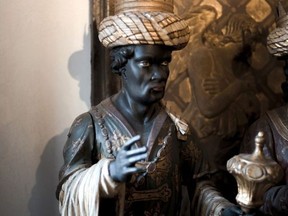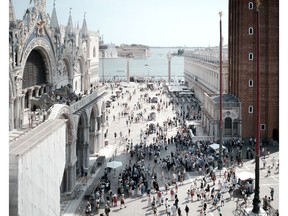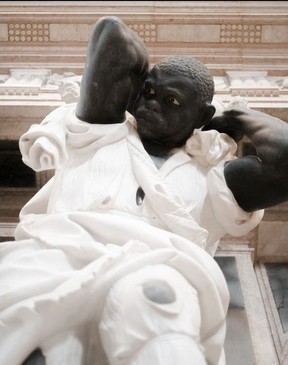Venice’s Black history is hiding in plain sight

Article content
Reviews and recommendations are unbiased and products are independently selected. Postmedia may earn an affiliate commission from purchases made through links on this page.
In the 15th century painting “Miracle of the Relic of the Cross at the Rialto Bridge,” a Black gondolier calmly rows his client through the centre of a frenetic scene. When you picture Venice’s famous canals, the boatmen might not match this description, but the Black character’s presence in the artwork isn’t a historical anomaly.
Vittore Carpaccio was painting Venetian life as it was: an international hub where different cultures across the world mixed freely – and where many of the boatmen were Black Africans.
The job of the gondolier, which is now dominated by white men, was at one time often held by Black professionals. According to the guidebook “African Venice,” that’s because “the tricky task of rowing standing up, as well as ability in swimming and diving, may have stemmed from their earlier lives on the islands and lagoons of the West African coast.”
This is just one of the little-known facts about the canal city’s surprising links to Africa.

From the Black Magus on the clock tower in St Mark’s Square, to the evocative street names referencing far-flung lands – Calle dello Spezier, Ponte de le Turchette – and the Asian and African tropes in the art of Tintoretto and Titian in churches around the city, Venice’s urban landscape reflects its former status as the seat of an empire that traded with both the East and the Global South.
“There are certain places in the world that we associate with Venice,” Shaul Bassi, a professor at Venice’s Ca’ Foscari University and the book’s co-author, told me. “We tend to think of Marco Polo’s travels to China, or the Silk Road – not Africa. And yet, to use a cliché, African Venice is hiding in plain sight.”
“African Venice,” originally published by the Venetian publishing house Wetlands and republished in April this year by Pennsylvania State University Press, draws attention to this Black presence. Curious about this history, I met with Bassi in the district of Dorsoduro to explore one of the book’s proposed itineraries.
One of our first stops was outside a residential building with a brass doorknob in the shape of a man’s head. The man’s hair is molded into tight curls – a motif of Blackness – and he’s wearing a crown. The bronze has oxidized around the eyes, turning a greenish blue that matches the color of the canals, while one tiny spot at the top of his crown has been burnished bright, a disc of gold where thousands of hands have touched it.
“We touch Africa all the time in this city,” Bassi said, “And don’t even notice it.”
Small symbols of Black Africa like this are woven into the Venetian landscape – along with more problematic depictions, like the Venetian tradition of selling Blackamoors. These representations of Black enslaved people as statues, household objects like candelabra or in brooches and earrings can still be found in workshops across the city.

“These representations are still valued goods in the increasingly commodified city and part and parcel of the standard tourist experience,” Bassi writes in the book.
Our walk led us to the Basilica di Santa Maria Gloriosa dei Frari, where the funerary monument of the 17th-century Doge Giovanni Pesaro shows one of the most blatant depictions of white supremacy in the city. Four enormous statues of muscular Black men in tattered clothing strain to hold up the white marble of Pesaro’s tomb, their faces set in brutal grimaces. Bassi explains that the monument regularly offends visitors, but it exemplifies Europe’s relationship with Africa.
“We can read it like a confession,” he said. “It narrates a very European story: Whatever is glorified here is based on the exploitation of others. Now it is the business of contemporary art to salvage these images of Blackness from marginality and anonymity.”
Venice, as the site of the international art biennale, is perhaps better-placed than many cities to lead the charge in reclaiming visual representations of Blackness – but if change is happening, it’s happening slowly.
Africa has historically been poorly represented at the event. But over half of participants at the 2023 Architecture Biennale, directed by Lesley Lokko, were African or from the African diaspora. Last year marked Africa’s largest-ever presence at the arts biennale, with Benin, Ethiopia, Tanzania and Senegal participating for the first time. Togo made its debut this year.
“Africa is a growing presence here in Venice, but African pavilions could do so much more if they had the same financing that other countries have,” explained Lidija Kostic Khachatourian, the founder of AKKA Project, a contemporary African art gallery in a pocket of streets near the Accademia Bridge.
She chose to open her gallery in Venice “because of the exchange that the city has had with both the Middle East and Africa,” adding that “it felt very romantic to connect the three continents in this way.”

AKKA Project offers a residency program to self-taught African artists, exposing them to the city’s rich art history and allowing them to learn practical skills about the contemporary art world. An exhibition by the gallery in partnership with Venice’s modern art museum Ca’ Pesaro in 2023 saw contemporary African artists added to the museum’s permanent collection for the first time, effectively inserting their art into Venetian heritage.
There are other ways in which African people have made the city their own. If you head into the warren of lanes in the city’s Castello district, you may come across the glassmaking workshop of Moulaye Niang, a Senegalese glassmaker who studied under master glassworkers on the island of Murano when he moved to Venice in 2001.
“I learned the technique here, but everything I do is inspired by my childhood in Africa,” he told me from behind his worktable where a naked flame purred as we talked. “When I sit in front of my flame, it’s like traveling through Senegal: the forests of Casamance, the desert on the border with Mauritania, the markets of Dakar. These vibrant colors come through in my work.”
He showed me how the traditional chevron glass bead design – dating back to the 15th century – was probably ordered by royal families in West Africa. “As soon as I saw this type of bead, I recognized the designs of Cameroon’s Bamiléké people,” Niang said.
African food has also emerged onto Venice’s restaurant scene, thanks to Hamed Ahmadi, an Afghan refugee who manages a chain of restaurants based around the concept of the refugee experience. When he was living in a welcome center in the region, he realized that the people making long overland journeys to get to Europe were creating unique – and delicious – dishes precisely because of the constraints they faced.
“Italy is usually the first country of entry for Africans coming to Europe,” he said. “The refugee experience is a transnational one – they cross many borders to get here. When people arrive in a new country, they recreate their family recipes with the ingredients that they have at hand and that are cheap.”
Ahmadi set about collecting these recipes, creating an inventive repertoire of reworked dishes that reflect the variety of the refugee experience. He opened the restaurant Africa Experience in 2016, which serves food from nine different African countries.
“Venice is very white, but in its blood it’s a city that has always been looking outwards. It’s a melting pot. Venetians have always been travelers,” Ahmadi said.
The city’s monoculture of tourism has had the effect of stifling that sense of openness, turning Venice into a destination for others rather than point of departure.
But Africa’s influence on the city is there – if you know where to look.











Postmedia is committed to maintaining a lively but civil forum for discussion. Please keep comments relevant and respectful. Comments may take up to an hour to appear on the site. You will receive an email if there is a reply to your comment, an update to a thread you follow or if a user you follow comments. Visit our Community Guidelines for more information.